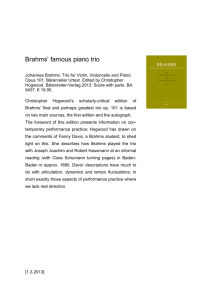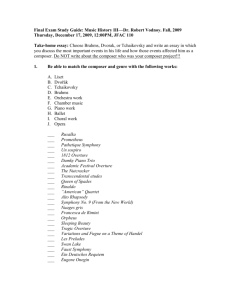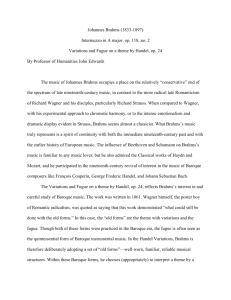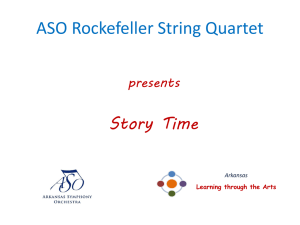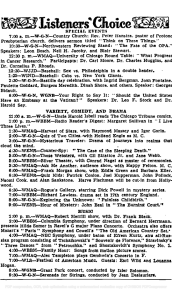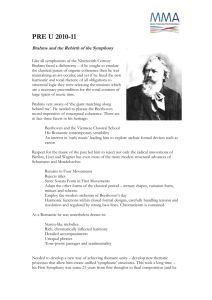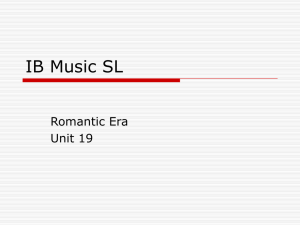JOHANNES BRAHMS (1833
advertisement
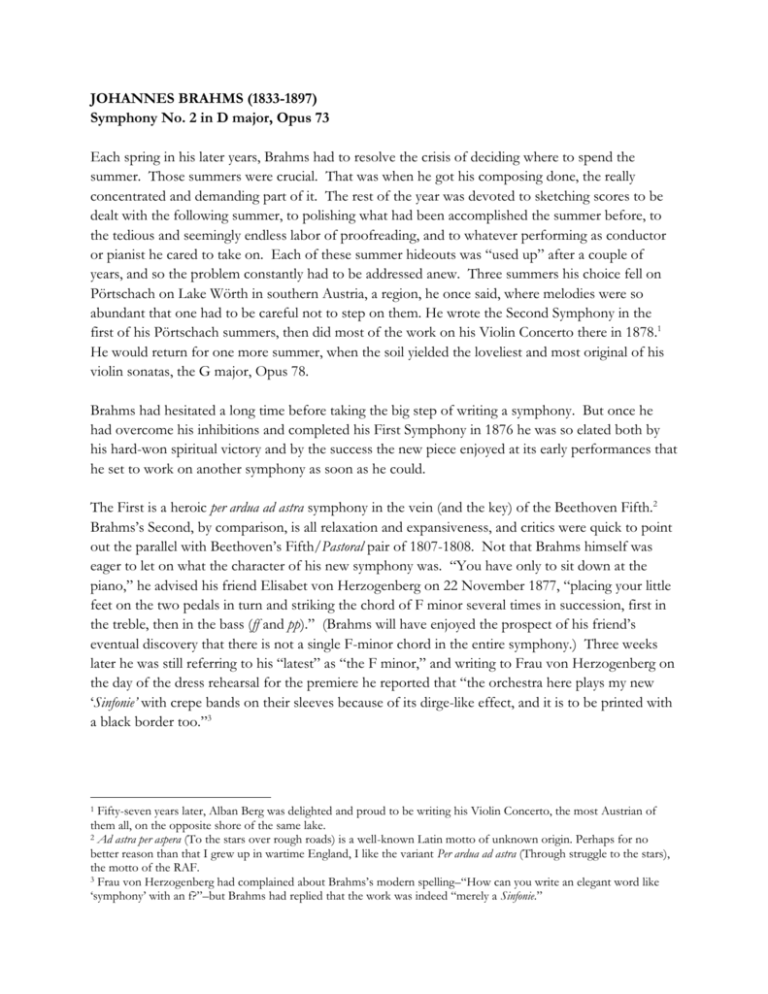
JOHANNES BRAHMS (1833-1897) Symphony No. 2 in D major, Opus 73 Each spring in his later years, Brahms had to resolve the crisis of deciding where to spend the summer. Those summers were crucial. That was when he got his composing done, the really concentrated and demanding part of it. The rest of the year was devoted to sketching scores to be dealt with the following summer, to polishing what had been accomplished the summer before, to the tedious and seemingly endless labor of proofreading, and to whatever performing as conductor or pianist he cared to take on. Each of these summer hideouts was “used up” after a couple of years, and so the problem constantly had to be addressed anew. Three summers his choice fell on Pörtschach on Lake Wörth in southern Austria, a region, he once said, where melodies were so abundant that one had to be careful not to step on them. He wrote the Second Symphony in the first of his Pörtschach summers, then did most of the work on his Violin Concerto there in 1878.1 He would return for one more summer, when the soil yielded the loveliest and most original of his violin sonatas, the G major, Opus 78. Brahms had hesitated a long time before taking the big step of writing a symphony. But once he had overcome his inhibitions and completed his First Symphony in 1876 he was so elated both by his hard-won spiritual victory and by the success the new piece enjoyed at its early performances that he set to work on another symphony as soon as he could. The First is a heroic per ardua ad astra symphony in the vein (and the key) of the Beethoven Fifth.2 Brahms’s Second, by comparison, is all relaxation and expansiveness, and critics were quick to point out the parallel with Beethoven’s Fifth/Pastoral pair of 1807-1808. Not that Brahms himself was eager to let on what the character of his new symphony was. “You have only to sit down at the piano,” he advised his friend Elisabet von Herzogenberg on 22 November 1877, “placing your little feet on the two pedals in turn and striking the chord of F minor several times in succession, first in the treble, then in the bass (ff and pp).” (Brahms will have enjoyed the prospect of his friend’s eventual discovery that there is not a single F-minor chord in the entire symphony.) Three weeks later he was still referring to his “latest” as “the F minor,” and writing to Frau von Herzogenberg on the day of the dress rehearsal for the premiere he reported that “the orchestra here plays my new ‘Sinfonie’ with crepe bands on their sleeves because of its dirge-like effect, and it is to be printed with a black border too.”3 Fifty-seven years later, Alban Berg was delighted and proud to be writing his Violin Concerto, the most Austrian of them all, on the opposite shore of the same lake. 2 Ad astra per aspera (To the stars over rough roads) is a well-known Latin motto of unknown origin. Perhaps for no better reason than that I grew up in wartime England, I like the variant Per ardua ad astra (Through struggle to the stars), the motto of the RAF. 3 Frau von Herzogenberg had complained about Brahms’s modern spelling–“How can you write an elegant word like ‘symphony’ with an f?”–but Brahms had replied that the work was indeed “merely a Sinfonie.” 1 Brahms played no such flirtatious games with the critic Eduard Hanslick, to whom he wrote, “In the course of the winter I shall let you hear a symphony that sounds so cheerful and delightful you will think I wrote it especially for you, or rather for your young wife.” The work went brilliantly in Vienna, and within the year there were performances, many of them under Brahms’s own direction, in Leipzig, Bremen, Amsterdam, The Hague, Hamburg, Dresden, Düsseldorf, and Breslau. The Dresden concert precipitated a crisis that Brahms enjoyed immensely. Clara Schumann was to be the pianist in Beethoven’s Choral Fantasy, but Franz Wüllner, newly appointed court conductor in Dresden, had put the Magic Fire Music from Die Walküre on the program too (he had led the first performances of Rheingold and Walküre), and Frau Schumann shuddered at the thought of sharing a program with the detested Wagner. “Imagine our poor friend’s torture,” wrote Brahms to Heinrich von Herzogenberg. “I shall of course write and urge her to come, though the whole thing is so comic that I shall find it hard to be serious about it.” Brahms actually expected Frau Schumann to cancel, but her professionalism and her curiosity about the new symphony overcame her musicopolitical principles and she kept the date. Elisabet von Herzogenberg, an intelligent but priggish and humorless woman, was very much on Clara Schumann’s side and thought Brahms’s attitude frivolous: “There really is a want of delicacy to the arrangement of the program. How can any audience be expected to appreciate really artistic work and a piece like the Magic Fire Music on one and the same evening? O Wüllner, Wüllner! I always thought you a gentleman, but this program betrays the impresario.” Much as Beethoven’s Pastoral, for all its “harmless” surface, is one of his most tightly composed works, so is the Brahms Second a singularly integrated, concentrated symphony. It begins with a double idea, a fairly neutral four-note motif in cellos and basses, upon which horns, joined almost at once by bassoons, superimpose a romantically atmospheric melody. But it is the bass component of this double theme that turns out to be crucial. Variants of that phrase appear five times in the next dozen or so measures. Brahms wants us to have it clearly in our ears, and for good reason: it is germinal to the entire symphony, many of whose ideas share the pattern of those first three notes (note, neighbor, return to the initial note). The first movement is uncommonly rich and varied in its material, the salient ideas being a threechord growl for low brass with cellos, bracketed between a soft drumroll and an isolation of the three-note motto; a soaring melody presented as a conversation between violins and flute and beginning with the three-note motto; a glowing tune for cellos and violas in thirds, with the cellos on top; and a buoyantly leaping theme – to be played quasi ritenente (as if held back) for just a little extra emphasis – with which Brahms celebrates his long-delayed arrival in the dominant, A major. There is much to listen to and to absorb, and that is a good reason for taking the repeat: from the Herzogenberg correspondence it emerges clearly that Brahms himself always did. The development reaches the extreme points, for this movement, both of dusky harmony and radiant physical energy. Brahms takes particular pains over the actual moment of recapitulation. He sends unmistakable signals by referring to the three-note motto (first at half speed and in softly shimmering tremolando), to the romantic horn phrase, and to the soaring violin-and-flute tune, but he manages the pacing of all this so subtly and is at the same time so canny about withholding a clear-cut D-major harmony that he seems magically to move straight from anticipation and expectation to a point where we realize the recapitulation is already under way. This is one of the exceedingly rare moments at which Brahms permits himself the marking “espressivo.” The coda brings another such moment, combined with a characteristically Brahmsian challenge – muffed outright by most conductors – to be at the same time sempre tranquillo and in tempo. Reviewing a Brahms concert by the Philadelphia Orchestra, Virgil Thomson wrote that he had heard a lady say on her way out of Carnegie Hall, “Brahms is so dependable.” We do rather think of him that way, not least because his music is so familiar, particularly the four symphonies. When it was new, though, his music was thought abstruse and excessively intellectual – in a word, “difficult.” Listening to the slow movement of the Second Symphony – really listening, that is, not just switching to automatic pilot the moment we’ve made sure they haven’t slipped in the Andante from the Fourth – we can perhaps recapture what made Brahms a difficult composer. Or, rather, what makes him a difficult composer, because some of his music is so tightly packed and densely argued that it still cuts the inattentive no slack. Nowhere is Brahms’s desire for concentration more evident than in this Adagio. The cello theme with which it begins, accompanied by the bassoons in contrary motion, is one of his most amazing inspirations. It is also a melody whose subtle internal repetitions and delicate rhythmic displacements make it, even with familiarity, anything other than easy for the conductor to shape and the listener to grasp. It was his intense study of Mozart and his knowledge of Renaissance and Baroque music that gave him his liking for and ease with rhythm other than the four-square. The first movement of the Second Symphony is sunny, but the sunshine is shadowed. Now, in the Adagio, which is in B major, the shadows and the moments of agitation that are background in the first movement come to the fore. The horn picks up a fragment of the cello melody and uses it to begin a fugue, though this is not developed far. A new theme, grazioso and given an element of caprice by its persistent syncopations, divides the measures differently so as to create the illusion of faster motion. A third idea in flowing, conjunct motion continues in this vein. Against this, various instruments in turn set agitated waves of sixteenth-notes so that the effect is one of ever faster motion. This is the background against which Brahms introduces the slowest music we have yet heard, the first movement’s three-note motto, now sounded as solemn warning by trombone and bassoon, answered by tuba and basses. Brahms does not choose to inject quicker notes here; he does, however, stir the blood by accelerating the rate at which the harmonies change, and it is with almost disorienting speed that in just one and a half quiet measures he travels across vast harmonic spaces to B major, so that the recapitulation can begin. Every detail, every relationship is reconsidered, and right up to those last melancholy descents of violins and clarinet that so beautifully set off the peaceful closing chords, the movement continues as it began – something always beyond our power to predict yet, at every turn, perfectly convincing. The third movement is one of those leisurely quasi-scherzos that are a Brahms specialty. The oboe starts it with an ambling dance tune. Mahler might have marked it “altväterisch”–old-fashioned. The first trio arrives very soon, scurrying, quicker, and a variation of the oboe tune, which is itself yet another expansion of the three-note motto. A second trio combines the light-footed gait of the first with the triple meter of the oboe theme and adds some witty off-beat accents of its own. The close is sweetly wistful. There follows a swift finale. The sotto voce opening is a variation of the first bars of the whole symphony. Later themes move more broadly across the measures, though not with less energy. A touch of gypsy music enlivens the scene, and this exuberant movement culminates in a blazing affirmation of D major (and, by the way, a wonderful demonstration of how exciting Brahms makes every trombone entrance by using those instruments sparingly and knowingly). © Michael Steinberg
